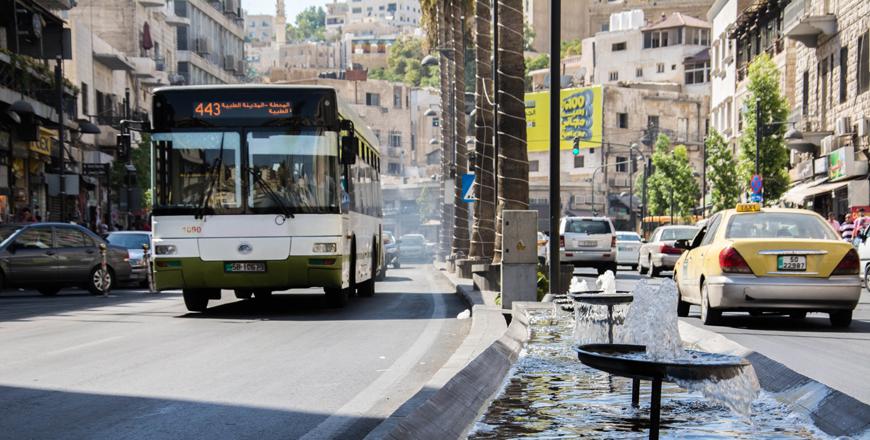You are here
Temperatures forecast to rise seven degrees above annual average this week
By Hana Namrouqa - Aug 16,2015 - Last updated at Aug 16,2015

A heatwave that started affecting the country on Saturday is expected to push temperatures to their upper thirties and last until Wednesday, according to the Jordan Meteorological Department (Photo by Amjad Ghsoun)
AMMAN — Temperatures on Monday are forecast to rise seven degrees above their annual average of 32ºC for this time of year, as the country remains under the impact of a heatwave, according to the Jordan Meteorological Department (JMD).
The heatwave, which started affecting the country on Saturday, is expected to push temperatures to their upper thirties and last until Wednesday, JMD Director General Mohammad Samawi said on Sunday.
“This heatwave is caused by a combination of a thermal low centred over the Arabian Peninsula and a seasonal depression originating from the north of the Indian subcontinent,” Samawi told The Jordan Times.
The highest temperature expected to be registered in Amman during this hot spell is 39ºC, he added, underscoring that impact of the current heatwave will be weaker than the one that affected the country earlier this month.
“This heatwave is categorised as average because temperatures in Amman will not exceed 39ºC and the average rise in temperatures across the country will be
5ºC-7ºC,” Samawi noted.
He explained that the JMD announces a heatwave when temperatures rise five degrees above the average for more than three days, and the period and the rise in temperatures control the intensity of a heatwave.
Dry and hot weather is expected to prevail across the country between Monday and Wednesday, while it will be very hot in the Jordan Valley, Aqaba, the badia and the eastern plains, according to the JMD.
Winds will be northwesterly moderate to brisk at times, raising dust in the desert.
The maximum temperature in the capital on Monday will range between 38ºC and 39ºC, dropping to a minimum of 25ºC, while on Tuesday temperatures will reach a high of 37ºC during the day, and drop to a low of 25ºC at night.
A slight rise in temperatures is forecast for Wednesday, when mercury levels will range between 24ºC and 39ºC in Amman, according to Samawi.
“As of Thursday, temperatures will start to drop gradually as the impact of the heatwave recedes,” he said, adding that it will be 36ºC during the daytime.
The JMD and the Civil Defence Department issued a number of instructions for the public to follow during the current heatwave to avoid sunstrokes and heat exhaustion.
Authorities called on people to avoid direct sun exposure and ventilate their houses, especially those with large windows.
In addition, motorists are advised to park their vehicles in shaded spots and not to leave children in unventilated cars.
People are also advised to drink four litres of fluids, while farmers should irrigate their crops at night or early in the morning.
To prevent crop damage as a result of the hot weather, the Jordan Valley Authority (JVA) on Sunday said it will continue to pump extra amounts of water to farmers.
The JVA started providing Jordan Valley farmers with additional irrigation water for crops and trees in late July, when temperatures started to rise well above their annual average.
During the hot spell earlier this month, water was pumped for an extra four hours to farmers in the Jordan Valley, where temperatures soared above 47°C.
Moreover, the JVA increased water allocations by 50,000 cubic metres per day in the northern part of the Jordan Valley, and by 100,000 cubic metres per day in the central and southern parts.
“The measures remain in place as hot weather continues to prevail, in order to help farmers,” JVA Secretary General Saad Abu Hammour told The Jordan Times on Sunday.
In addition, the JVA has increased monitoring of water resources across the Jordan Valley to prevent violations on networks and carriers, according to Abu Hammour.
“Our patrols are protecting the King Abdullah Canal in particular because during such hot weather, people tend to install pipes to pump out water, while others swim in the canal, thus endangering their own lives and polluting the canal,” he said.
The 110-kilometre King Abdullah Canal, which is supplied by the Yarmouk River, irrigates 40 per cent of the crops in the Jordan Valley and provides some 40 per cent of the capital’s water after it is treated at the Zai treatment plant.
Related Articles
AMMAN — The heatwave that started affecting the Kingdom on Saturday, pushing temperatures to their upper thirties, is forecast to ease off s
AMMAN – The heatwave that started affecting the country last week is expected to continue, with temperatures rising seven to eight degrees a
AMMAN — The Jordan Valley Authority (JVA) on Sunday increased the amount of irrigation water to farmers to prevent crop damage in light of t
















